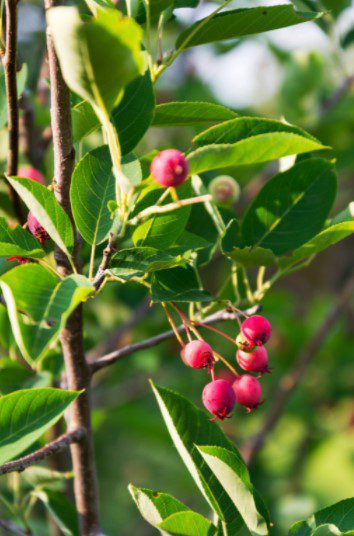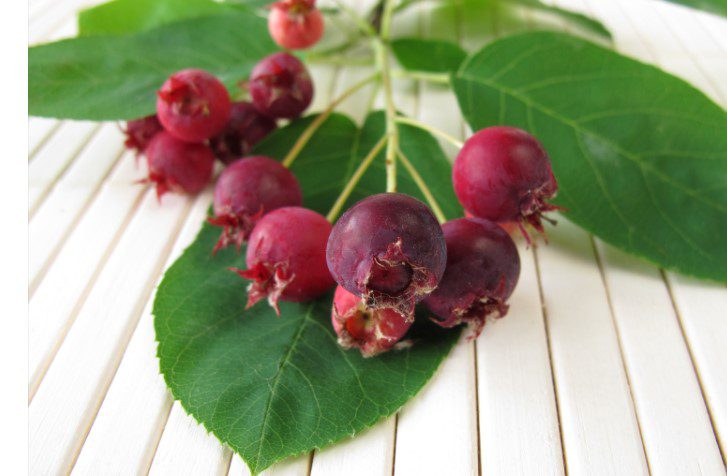Juneberry
What is a juneberry? It’s a dark purple berry that is slightly larger than a blueberry but has a more apple-cherry taste, firmer texture, and tiny seeds inside that impart an almond essence.
In midwestern Canada, they are also called Saskatoons and are prized in pies and jams and fresh consumption.
“Once you start eating them fresh, you can’t stop,” says Ochterski.
If flavor alone doesn’t sway consumers toward juneberries, then their nutritional profile should help.
Because they have less moisture than blueberries, juneberries pack more fiber, calcium, antioxidants, and protein and are an excellent source of iron.
Horticulturally speaking, the commercial species (Amelanchier alnifolia) is related to the serviceberry shrub (Amelanchier Canadensis) that grows in local forests.
How to Harvest Juneberries
It’s there, have you noticed it? It’s common for Juneberries to be ready for picking around this time of year – you wouldn’t believe it! The plants usually bloom in the early spring.
After 45-60 days, the fruit should be ready for picking. The berries will turn a deep purple color when they ripen and look very much like a blueberry.
The fruits are mildly sweet when ripe. If you are looking for a large harvest, it is worth putting up nets or cages to protect your bush.
More on Juneberry Plus 1 Delicious Recipes
For those of you who need immediate gratification, this week’s recipe is all about blueberries. But for anyone who wants to gaze into the region’s fruity future, let me introduce you to the Juneberry.
I know, I know, it’s almost bloody August. But Juneberries might be a new item at your local farmers market come next June.

Juneberries appear and taste much like blueberries but have a firmer texture with tiny, edible seeds in the center. The texture reminds me a little bit of pear, while the flavor is a cross between blueberry, plum, cherry, and a hint of almond. Botanically, they are called Amelanchier alnifolia and belong in the Rosacea family, along with apples, plums, and cherries.
Juneberries thrive in the western prairie states and Canada, which is why they are also known as Saskatoon berries. You might also hear them called shadberries (because they bloom during the season when the shad migrate up rivers) or serviceberries.
Their harvest window is short, bridging the time between strawberries and raspberries, from mid-June to early July.
Last year, four farms in the Finger Lakes region planted about 400 Juneberry bushes to see how well they’d grow in the Northeast climate.
The pilot project, sponsored by a Northeast Sustainable Agriculture Research and Education program, also tests the waters for marketability.
Jim Ochterski, agriculture agent at Cornell Cooperative Extension of Ontario County, is overseeing the project and recently shared some Juneberries with me that he brought back from Michigan.
“They are native to North America and easy to grow, but it has never made the jump to the Northeast United States as a fruit of interest. Nobody has tested the market; I’m the first person to bring it here,” he says.
Nutritionally, Juneberries have even more fiber, antioxidants, and protein than blueberries, notes Ochterski. Another selling point: They have a longer shelf life and hold their shape better after freezing.
In the kitchen, you can do Juneberries anything you would do with blueberries: pies, jams, muffins, fruit salads, sauces, and pancakes.
The recipe below lets you enjoy the Juneberries or blueberries with a minimal amount of intervention. It’s a great breakfast salad or light summer dessert.
Try it now with blueberries, and next year, if production goes well, with Juneberries.
Spiced Fresh Blueberries (or Juneberries)
Ingredients:
1/2 cup sugar
Two teaspoons lemon juice
Two cinnamon sticks
Four whole cloves
1 pint fresh blueberries (or Juneberries)
Preparation:
- Mix sugar, lemon juice, cinnamon, cloves with 1 cup water in a saucepan.
- Induce to a boiling point, simmer for 5 minutes.
- Cool.
- Pour through a strainer over the berries.
- Chill for 30 minutes.
- If berries are cold, bring them to room temperature before serving with some of the liquid.
Serves: 4



























Comments are closed.